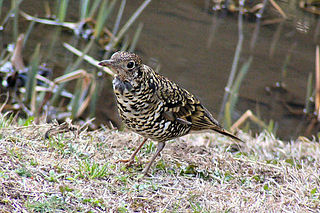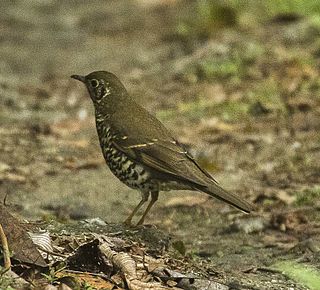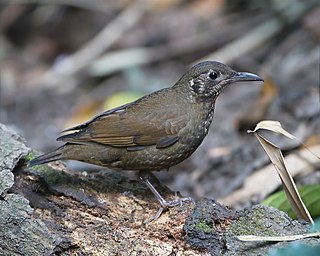
The orange-headed thrush is a bird in the thrush family.

The scaly thrush is a member of the thrush family Turdidae.

The Siberian thrush is a member of the thrush family, Turdidae. The genus name Geokichla comes from Ancient Greek geo-, "ground-" and kikhle, " thrush". The specific sibirica is Latin for Siberia.

The Asian thrushes are medium-sized mostly insectivorous or omnivorous birds in the genus Zoothera of the thrush family, Turdidae.

The black wheatear is a wheatear, a small passerine bird in the Old World flycatcher family Muscicapidae. It is found in the Iberian Peninsula and western North Africa.

The hermit thrush is a medium-sized North American thrush. It is not very closely related to the other North American migrant species of Catharus, but rather to the Mexican russet nightingale-thrush. The specific name guttatus is Latin for "spotted", though historically this species has been given 17 additional species or subspecies names by various authors, now all treated as synonyms.

The pied thrush is a member of the thrush family found in India and Sri Lanka. The males are conspicuously patterned in black and white while the females are olive brown and speckled. They breed in the central Himalayan forests and winter in the hill forests of southern India and Sri Lanka. Like many other thrushes, they forage on leaf litter below forest undergrowth and fly into trees when disturbed and sit still making them difficult to locate.

The Amami thrush is a member of the thrush family Turdidae. It is endemic to the islands of Amami Ōshima and Kakeroma island in the northern Nansei Islands of Japan.

The geomalia or Sulawesi mountain thrush is a rare member of the thrush family endemic to Sulawesi in Indonesia. It is sometimes classified as Geomalia heinrichi, in which case it is monotypic in the genus Geomalia.

The Bassian thrush, also known as the olive-tailed thrush, is a medium-sized mostly insectivorous thrush found from northern Queensland to southeastern Australia; it also occurs in Tasmania, on some larger islands of Bass Strait, and on Kangaroo Island. The thrushes range from 27 to 29 cm in length and average 100 g (3.5 oz).

The Abyssinian ground thrush is a thrush from the family Turdidae which is native to north-east Africa where it lives at high altitude in montane forests. Its binomial nomenclature honors the 19th century Italian explorer of East Africa Carlo Piaggia.

The long-tailed thrush is a species of bird in the family Turdidae. It is found from the central and eastern Himalayas to south-central and south-western China. Its natural habitats are subtropical or tropical moist montane forests and subtropical or tropical high-altitude shrubland.

The dark-sided thrush is a species of bird in the thrush family Turdidae. It is also known as the lesser brown thrush, the long-billed ground-thrush, and the dark-sided ground-thrush. The species is monotypic and is closely related to a number of thrushes in the genus Zoothera, including the long-billed thrush and the widespread scaly thrush. It was described by Edward Blyth in 1847 based upon a specimen collected in Rakhine in Burma (Myanmar).

The long-billed thrush is a species of bird in the family Turdidae. It is found from the Himalayas to Myanmar and Vietnam. Its natural habitat is subtropical or tropical moist montane forests.

The Aztec thrush is a species of bird in the family Turdidae. It is found mainly in Mexico, but vagrants are occasionally seen in the United States. Its natural habitat is montane forests. The IUCN Red List denotes it as a least-concern species.
The black-backed thrush or New Britain thrush is a species of bird in the family Turdidae. It is endemic to Papua New Guinea where it occurs on the islands of New Britain, Umboi and Bougainville. Its natural habitats are temperate, subtropical or tropical moist lowland forests and subtropical or tropical moist montane forests.

The Sri Lanka thrush or Sri Lanka scaly thrush is a member of the thrush family Turdidae. This bird is a non-migratory resident breeder found in south western rainforests of the island of Sri Lanka.

The Geokichla thrushes are medium-sized mostly insectivorous or omnivorous birds in the thrush family, Turdidae. They were traditionally listed in the Zoothera, but molecular phylogenetic studies published in 2008 led to their placement in a separate genus.

The Nilgiri thrush is a member of the thrush family.

The Himalayan thrush or Himalayan forest thrush is a species of bird described in 2016 and separated out from the alpine thrush Zoothera mollissima with which they were formerly lumped. The species is separated on the basis of phylogenetic studies that suggest that the population diverged from the common ancestor at least 3 million years ago. The alpine thrush breeds above the tree line whereas the Himalayan thrush breeds in forested habitats. The species breeds from Sikkim and Darjeeling in India and extends east into Tibet and further east into northwest Yunnan in China. The species differs in its song from that of the alpine thrush. The Himalayan thrush has a more musical call while that of the Alpine thrush is raspy and grating. A newly discovered Himalayan forest thrush bird was named after the birdman of India, Ornithologist Dr.Salim Ali. The name of the bird is "Zoothera salimalii". A fruit bat is also named after him "Latidens salimalii"




















